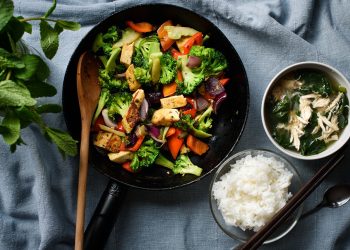The DASH (Dietary Approaches to Stop Hypertension) diet was originally designed to help manage blood pressure, but its health benefits extend far beyond heart health. This eating plan has gained recognition as an effective strategy for weight loss, offering a balanced approach that prioritizes nutrient-dense foods while minimizing processed options. Here’s an in-depth look at the DASH diet and how it can help you achieve your weight loss goals while promoting overall well-being.
What Is the DASH Diet?
The DASH diet emphasizes whole, nutrient-rich foods and limits those high in sodium, saturated fats, and added sugars. It’s not a fad diet but a sustainable, long-term eating plan backed by extensive research. Key components of the DASH diet include:
- Plenty of Vegetables and Fruits:
- Aim for 4-5 servings of vegetables and 4-5 servings of fruits daily. These provide essential vitamins, minerals, and fiber while being naturally low in calories.
- Whole Grains:
- Include 6-8 servings of whole grains, such as brown rice, quinoa, oats, and whole-grain bread. These complex carbohydrates provide sustained energy and are rich in fiber.
- Lean Proteins:
- Focus on lean sources of protein like fish, poultry, legumes, and nuts. Limit red meat and processed meats.
- Low-Fat Dairy:
- Incorporate 2-3 servings of low-fat or fat-free dairy products like milk, yogurt, and cheese.
- Healthy Fats:
- Opt for heart-healthy fats from sources like avocados, nuts, seeds, and olive oil. Limit saturated and trans fats.
- Low Sodium:
- Keep sodium intake to less than 2,300 mg per day, or 1,500 mg for those with hypertension or high cardiovascular risk.
Why the DASH Diet Works for Weight Loss
- Calorie Control:
- The DASH diet naturally reduces calorie intake by focusing on whole, low-calorie foods. Its emphasis on portion control and nutrient density helps create a calorie deficit without extreme restrictions.
- Satiety from Fiber:
- High-fiber foods like vegetables, fruits, and whole grains promote fullness and reduce hunger between meals, making it easier to stick to your eating plan.
- Balanced Macronutrients:
- The diet’s balance of carbohydrates, proteins, and fats ensures stable blood sugar levels and sustained energy, reducing cravings for unhealthy snacks.
- Reduced Sodium:
- Lower sodium intake reduces water retention and bloating, which can contribute to a leaner appearance and lower weight.
Building a DASH Diet Meal Plan
- Breakfast Ideas:
- Oatmeal with Fresh Berries:
- Cooked oats topped with blueberries, a sprinkle of chia seeds, and a drizzle of honey.
- Veggie Omelet with Whole-Grain Toast:
- Eggs cooked with spinach, tomatoes, and onions, served with a slice of whole-grain bread.
- Lunch Ideas:
- Grilled Chicken Salad:
- Mixed greens with grilled chicken, cherry tomatoes, cucumbers, and a vinaigrette dressing.
- Quinoa Bowl:
- Quinoa topped with roasted vegetables, chickpeas, and a tahini drizzle.
- Dinner Ideas:
- Baked Salmon with Steamed Broccoli:
- Salmon seasoned with herbs and lemon, paired with a side of broccoli and brown rice.
- Turkey Stir-Fry:
- Ground turkey stir-fried with colorful bell peppers, snap peas, and a low-sodium soy sauce.
- Snack Ideas:
- A handful of almonds or walnuts.
- Low-fat yogurt with sliced bananas.
- Fresh veggies with hummus.
Tips for Following the DASH Diet
- Plan Your Meals:
- Create a weekly meal plan and grocery list to ensure you have all the ingredients needed for balanced meals.
- Read Nutrition Labels:
- Check sodium content on packaged foods and opt for low-sodium or no-salt-added options whenever possible.
- Cook at Home:
- Preparing meals at home gives you control over ingredients, portion sizes, and sodium levels.
- Incorporate Variety:
- Rotate fruits, vegetables, proteins, and grains to keep meals exciting and nutritionally diverse.
- Stay Hydrated:
- Drink plenty of water throughout the day. Limit sugary drinks and alcohol.
Benefits Beyond Weight Loss
- Improved Heart Health:
- By reducing sodium and saturated fat, the DASH diet lowers blood pressure and improves cholesterol levels, reducing the risk of heart disease.
- Better Blood Sugar Control:
- The diet’s focus on whole grains and fiber helps regulate blood sugar levels, making it beneficial for individuals with type 2 diabetes or prediabetes.
- Enhanced Energy Levels:
- Nutrient-rich foods provide steady energy throughout the day, improving overall productivity and mood.
- Reduced Inflammation:
- Antioxidant-rich fruits and vegetables combat inflammation, supporting joint health and reducing the risk of chronic diseases.
Overcoming Challenges
- Time Constraints:
- Batch cook meals and prep ingredients in advance to save time during busy weekdays.
- Adapting to Lower Sodium:
- Gradually reduce salt in recipes and use herbs, spices, and citrus to enhance flavor.
- Dining Out:
- Choose restaurants that offer healthy options, and ask for sauces or dressings on the side to control sodium and calorie intake.
- Budget-Friendly Tips:
- Buy seasonal produce and frozen fruits and vegetables to save money without sacrificing nutrition.
Staying Motivated
- Track Your Progress:
- Use a food diary or app to monitor your meals and stay accountable.
- Celebrate Small Wins:
- Acknowledge milestones like lowering blood pressure or losing a few pounds to stay motivated.
- Seek Support:
- Share your goals with friends or join a community of individuals following the DASH diet for encouragement and recipe ideas.
By focusing on whole, nutrient-dense foods and making gradual, sustainable changes, the DASH diet offers a heart-healthy and effective path to weight loss. Its balanced approach ensures you’re not only shedding pounds but also improving your overall health and quality of life.










